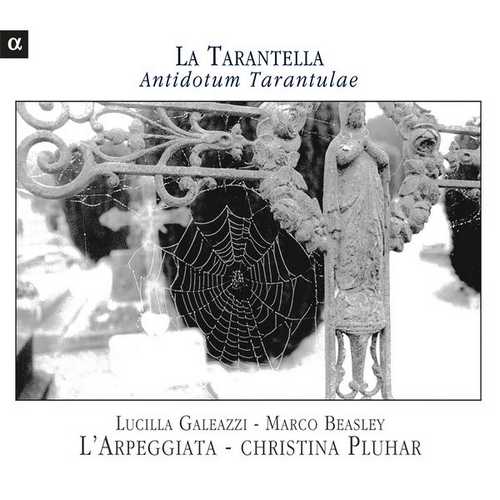
Performer: Lucilla Galeazzi, Marco Beasley, L’Arpeggiata
Conductor: Christina Pluhar
Format: FLAC (tracks)
Label: Alpha
Catalogue: ALPHA503
Release: 2002
Size: 278 MB
Recovery: +3%
Scan: yes
01. La Carpinese (Tarantella)
02. Lu Gattu la sonava la zampogna
03. Tarantella napoletana, Tono hypodorico
04. Lu passariellu (Tarantella dell’Avena)
05. Lamento dei mendicanti
06. Luna lunedda (Pizzica)
07. Ah, vita bella !
08. Tarantella del Gargano
09. Pizzicarella mia (Pizzica tarantata)
10. Silenzio d’amuri
11. Tarantella calabrese
12. Sogna fiore mio (Ninna nanna sopra la Tarantella)
13. Tarantella italiana
14. Tu bella ca lu tient lu pettu tundu (Tarantella)
15. Pizzica ucci
16. Lu povero ‘Ntonuccio (Lamento funebre)
17. Antidotum tarantulae
This album is not just about the southern Italian tarantella dance; it actually proclaims itself as an antidotum Tarantulae, an antidote to the bite of the tarantula. Both the spider (which is not the same animal as the feared tarantula of the southwestern U.S.) and, indirectly, the dance are named for the city of Taranto in southern Italy. La Tarantella presents tarantellas interspersed with other songs of the region, some traditional, others with known composers.
The texts of the vocal pieces are in southern Italian dialects, translated in the booklet into modern Italian, French, and English. The liner notes, in French and English only, are a delightfully diverse lot, with excerpts from writings dating back to the Renaissance, medical and more metaphysical musings on the “tarantism” phenomenon, and several passages that invite the listener to experience the tarantella phenomenon for herself or himself.
The pieces included touch not only on the dance but on phenomena that influence the bodily “humors” that the spider’s poison was thought to affect. Thus there are songs of love, night, poverty and alms-giving, and more. Some are dances with lots of percussion, others are melancholy. As L’Arpeggiata leader Christina Pluhar writes, “Each of these pieces presents a musical universe in itself, and is functional, therapeutic music, which could stretch over several hours or days, as required. The decision to enclose these dances in a restricted period of time has a practical basis: the real amount of time that can be pressed on a CD.” Keep this in mind if L’Arpeggiata gives a concert in your town! “It is left up to the listener to play the pieces in sequence, or to pick out a song that elicits a particularly strong reaction from him,” Pluhar goes on.
Plainly, this is one of the more original album conceptions of recent years. If you’re afraid of spiders, don’t buy it; there are several close-ups of the beasts in the booklet notes. And, since the tarantella is still ritually danced in certain southern Italian towns, it would be interesting to know whether it’s a louder thing, danced to music with a stronger tendency to break down physical and mental defenses, than what Pluhar presents here. The dominant sound on La Tarantella is Pluhar’s Baroque harp, accompanying some very expressive but subtle singers. These questions aside, La Tarantella is quite an intellectual adventure, and you can’t say that about every early music release.